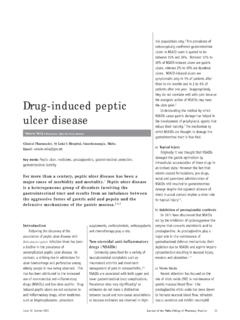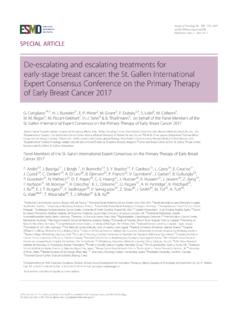Transcription of Evidence-based drug therapy in the management of heart failure
1 Issue 17 Summer 2011 Journal of the Malta College of Pharmacy Practice 5 IntroductionHF occurs when the heart is unable to deliver blood and oxygen at a rate that meets the requirements of the body. It is characterised by symptoms of breathlessness, fatigue upon exertion, and signs of fluid retention. Some people with HF have left ventricular systolic dysfunction (LVSD), with reduced left ventricular ejection fraction, typically identified on echocardiography. Others have HF with a preserved ejection fraction. Most of the evidence relating to drug treatment is for HF due to Two classifications of Evidence-based drug therapy in the management of heart failureClinical Pharmacist, Rehabilitation Hospital Karin Grech, G Mangia, : wordsheart failure , angiotensin-converting enzyme inhibitors, beta-blockers, loop diuretics, aldosterone antagonists, angiotensin receptor blockersEducational aims To provide an update of the most recent guideline recommendations for the pharmacotherapeutic management of heart failure .
2 To distinguish between those drugs which offer symptomatic relief and those which offer prognostic benefit. To highlight the monitoring requirements associated with the drugs severity of HF are commonly employed (Figure 1). The New York heart Association (NYHA) functional classification is based on symptoms and exercise capacity and is employed routinely in most randomized clinical The American College of Cardiology/American heart Association (ACC/AHA) classification describes HF in stages based on structural changes and The most common cause of HF is coronary artery disease, which accounts for around 70% of Other causes are hypertension, valvular disease, and arrhythmias such as atrial fibrillation. Advancing age, smoking, hyperlipidaemia and diabetes mellitus are among the associated risk factors. Infections, anaemia, alcohol abuse, side effects of medication such as non-steroidal anti-inflammatory drugs, and non-compliance with prescribed treatment can also exacerbate In Europe, the prevalence of HF is between 2 and 3% and rises sharply at around 75 years of age; the prevalence in seventy to eighty year-old people is between 10 and 20%.
3 In younger age groups HF is more common in men because the most common cause, coronary heart disease, occurs in earlier decades. In the elderly, the prevalence is equal between the The overall prevalence of HF is increasing because of ageing of the population, improved survival of patients with coronary artery disease and more effective treatments for treatment strategyPatients with HF have a shorter life expectancy and experience symptoms that can reduce their quality of life. The aims of treatment are to reduce the risk of mortality, delay disease progression, control symptoms and improve quality of life. Over the past two decades, the therapeutic approach to HF patients has undergone considerable change. Several drug classes have been introduced targeting the two biological pathways implicated in progression of the disease, the renin-angiotensin-aldosterone system and the sympathetic nervous system. Current treatment not only concerns symptomatic improvement, but increasingly focuses on delaying disease progression and on reducing mortality.
4 Angiotensin-converting enzyme inhibitorsThere is evidence to support the use of angiotensin-converting enzyme inhibitors (ACEIs) in all patients with LVSD. ACEIs improve symptoms, reduce hospitalisation rate, and improve survival ,8,9,10,11 ACEIs should be offered to all patients with HF due to LVSD (Figure 2).1 ACEIs should be started at a low dose and titrated upwards at short intervals of at least two weeks until the optimal tolerated or target dose is achieved. The safety of treatment with ACEIs is best achieved by monitoring serum potassium, urea, creatinine and estimated glomerular filtration rate (eGFR) before the initiation of ACEIs, one to two weeks following each dose increment, and then every three to six-months ,5 Hyperkalaemia is Marise Gauci BPharm (Hons), MScThis article provides an update on the drug treatment for heart failure (HF) mostly based on the recent clinical guidelines issued by the National Institute of Clinical Excellence (NICE).1 New high quality evidence from randomised controlled trials has resulted in greater value being given to the use of beta-blockers (BBs) and to the use of the hydralazine-nitrate combination.
5 The importance of monitoring laboratory and clinical parameters to ensure safe and effective drug treatment is also 17 Summer 20116 Journal of the Malta College of Pharmacy Practicea potential problem during therapy . Mildly raised potassium levels ( ) can often be managed by dietary modifications (foods containing high levels of potassium banana, tomatoes and citrus fruits to be avoided). Cessation of treatment should only be considered if serum potassium is more than 6 ,5 An increase in creatinine is expected when an ACEI is initiated, but the action taken should be determined by the extent of the rise. According to guidelines from the European Society of Cardiology, an increase in creatinine of up to 50% from baseline or to an absolute concentration of 265 mol/L, whichever is lower, is acceptable. If the creatinine rises above 265 mol/L, but below 310 mol/L, the dose of ACEI should be halved. If the creatinine rises to 310 mol/L or above, the ACEI should be stopped According to NICE guidelines, a change in creatinine of less than 30% or in eGFR of less than 25% is acceptable; if the change is greater, the ACEI should be stopped or the dose reduced to a previously tolerated lower is a common adverse effect of ACEIs and switching to an angiotensin receptor blocker is Symptomatic hypotension ( dizziness) is also common but often improves with time, and patients should be reassured.
6 Reducing the dose of diuretics and other hypotensive agents should be considered. Asymptomatic hypotension does not require receptor blockersThere is significant evidence supporting to use of angiotensin receptor blockers (ARBs) in the management of HF, although this is weaker than that for ,13,14,15,16,17 Unlike ACEIs they do not cause dry cough, one of the most common causes of stopping ACEI therapy . When patients are intolerant of ACEIs, the introduction of ARBs is proposed as an ARBs are also recommended as second-line treatment if a patient remains symptomatic despite optimal therapy with an ACEI and a BB, especially if the patient has mild to moderate HF (NYHA class II-III) (figure 2).1 Monitoring of serum potassium, urea, creatinine and eGFR for signs of hyperkalaemia or renal impairment is recommended as for blockersPatients who have HF with LVSD should be considered for the introduction of BBs. In these patients BBs have been shown to reduce morbidity, hospitalisation and mortality.
7 BBs of proven efficacy in HF include carvedilol, nebivolol, bisoprolol and metoprolol ,19,20,21,22,23,24 According to the recent NICE guidelines (figure 2), both ACEIs and BBs licensed for HF should be offered to all patients with HF due to LVSD, using clinical judgement when deciding which drug to start This recommendation resulted from evidence from the CIBIS III trial indicating that HF patients derived similar outcome of therapy with ACEIs followed by BBs, to those treated with BBs followed by The clinical decision to use one of these two agents before the other depends on the clinical status of the patient. Several factors could affect the choice, including blood pressure, heart rate as well as the presence of symptomatic ischaemia, arrhythmias and other BBs should not be withheld from older adults and patients with peripheral vascular disease (unless severe), erectile dysfunction, diabetes mellitus, interstitial pulmonary disease and chronic obstructive pulmonary disease without reversibility.
8 Stable patients who are already taking a BB for a concurrent disease ( angina or hypertension) and who develop HF due to LVSD, should be switched to a BB licensed for should be started in stable patients at low doses and up-titrated slowly at intervals of at least two to four weeks. It is important, during the up-titration of BBs, to monitor the patient s pulse rate, blood pressure and the clinical status, to avoid side effects such as symptomatic bradycardia and symptomatic hypotension. The up-titration should be undertaken gradually and slowly to achieve the target doses used in the clinical trials, if tolerated. The patient needs to be informed that transient pulmonary congestion could occur at times during up-titration of ,5 Aldosterone antagonistsThere is evidence of enhanced activity of the renin-angiotensin-aldosterone system in patients with HF. The modulation of this system started with the introduction of ACEIs, and followed by the introduction of the ARBs in the treatment of HF.
9 Spironolactone, an aldosterone antagonist (AA), was contra-indicated in combination with ACEIs, until the publication of the RALES study in evidence from this study indicated that moderately to severely symptomatic patients with HF (NYHA class III-IV), despite optimal medical therapy , attained lower hospitalisation rates and higher survival rates with the addition of spironolactone. A more recent trial investigating the newer AA, eplerenone, in patients with LVSD and clinical evidence of HF or diabetes mellitus within 14 days of a myocardial infarction (MI) also showed prognostic benefit in these In fact ACC/AHA stages of heart failureNYHA functional classificationStage of heart failure based on structure and damage to heart muscleSeverity based on symptoms and physical activityStage AAt high risk for developing heart failure . No identified structural or functional abnormality; no signs or INo limitation of physical activity. Ordinary physical activity does not cause undue fatigue, palpitation, or BDeveloped structural heart disease that is strongly associated with the development of heart failure , but without signs or IISlight limitation of physical activity.
10 Comfortable at rest, but ordinary physical activity results in fatigue, palpitation, or CSymptomatic heart failure associated with underlying structural heart IIIM arked limitation of physical activity. Comfortable at rest, but less than ordinary activity results in fatigue, palpitation, or DAdvanced structural heart disease and marked symptoms of heart failure at rest despite maximal medical IVUnable to carry on any physical activity without discomfort. Symptoms at rest. If any physical activity is undertaken, discomfort is American College of Cardiology; AHA American heart Association; NYHA New York heart AssociationFigure 1: Classification of heart failure by structural abnormality (ACC/AHA), or by symptoms relating to functional capacity (NYHA)Figure 2: NICE algorithm for the treatment of heart failure (HF)1 HFHF with preserved ejection fractionHF due to left ventricular systolic dysfunctionManage comorbid conditions such as high blood pressure, ischaemic heart disease and diabetes mellitus in line with NICE guidanceIf symptoms persist despite optimal first-line treatment, seek specialist advice and for second-line treatment consider adding: an AA licensed for HF (especially in moderate to severe HF/MI in past month) or an ARB licensed for HF (especially in mild to moderate HF) or hydralazine in combination with nitrate (especially in people of African or Caribbean origin with moderate to severe HF)Offer both ACEIs and BBs licensed for HF as first-line treatmentIf sysmptoms persist.

